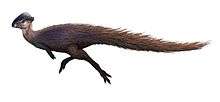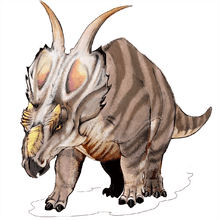Polyonax
| Polyonax Temporal range: Late Cretaceous, 66 Ma | |
|---|---|
| Scientific classification | |
| Kingdom: | Animalia |
| Phylum: | Chordata |
| Class: | Reptilia |
| Clade: | Dinosauria |
| Order: | †Ornithischia |
| Family: | †Ceratopsidae |
| Subfamily: | †Chasmosaurinae |
| Tribe: | †Triceratopsini |
| Genus: | †Polyonax Cope, 1874 |
| Species: | †P. mortuarius |
| Binomial name | |
| Polyonax mortuarius Cope, 1874 | |
Polyonax (meaning "master over many") was a genus of ceratopsid dinosaur from the late Maastrichtian-age Upper Cretaceous Denver Formation of Colorado, United States. Founded upon poor remains, it is today regarded as a dubious name.
History
During an 1873 trip through the western US, paleontologist and naturalist Edward Drinker Cope collected some fragmentary dinosaurian material which he soon named as a new genus.[1] Catalogued today as AMNH FR 3950,[2] the type material included three dorsal vertebrae, limb bone material, and what are now known to be horn cores, from a subadult individual.[3] Although it was briefly mixed up with hadrosaurs, and even considered to be a possible synonym of Trachodon,[4] it was recognized as a horned dinosaur in time for the first monograph on horned dinosaurs (1907), wherein it was regarded as based on indeterminate material.[5] Today, the name is used as little more than a historical curiosity, as it dates from a time before horned dinosaurs were known to exist.[6] The most recent review listed it as an indeterminate ceratopsid.[7]
It has sometimes been listed as a synonym of Agathaumas,[8] or Triceratops.[9]
Paleobiology
As a ceratopsid, Polyonax would have been a large, quadrupedal herbivore, with horns and a neck frill.[7]
See also
References
- ↑ Cope, E.D. (1874). Report on the stratigraphy and Pliocene vertebrate paleontology of northern Colorado. Bulletin of the U.S. Geological and Geographical Survey of the Territories. 9:9-28.
- ↑ "American Museum of Natural History - Division of Paleontology - FR 3950".
- ↑ Glut, D.F. (1997). "Polyonax". Dinosaurs: The Encyclopedia. McFarland & Company. pp. 723–724. ISBN 0-89950-917-7.
- ↑ Hatcher, J.B. (1902). The genus and species of the Trachodontidae (Hadrosauridae, Claosauridae) Marsh. Annals of the Carnegie Museum 14(1):377-386.
- ↑ Hatcher, J.B., Marsh, O.C., and Lull, R.S. (1907). The Ceratopsia. Government Printing Office:Washington, D.C., 300 pp. ISBN 0-405-12713-8
- ↑ Dodson, P. (1996). The Horned Dinosaurs. Princeton University Press:Princeton, New Jersey. ISBN 0-691-02882-6.
- 1 2 Dodson, P., Forster, C.A., and Sampson, S.D. (2004). Ceratopsidae. In: Weishampel, D.B., Dodson, P., and Osmólska, H. (eds.). The Dinosauria (second edition). University of California Press:Berkeley, 494-513. ISBN 0-520-24209-2.
- ↑ Romer, A.S. (1956). Osteology of the Reptiles. University of Chicago Press:Chicago, 1-772. ISBN 0-89464-985-X.
- ↑ Lambert, D., and the Diagram Group. (1990). The Dinosaur Data Book. Facts on File:Oxford, England, 320 p.


